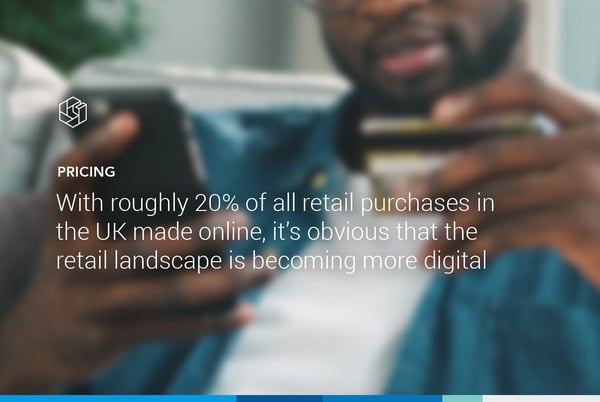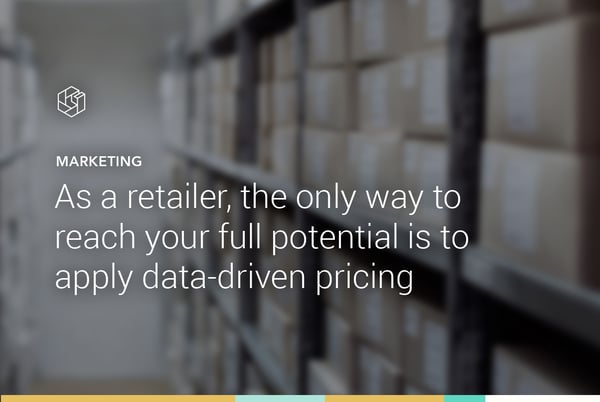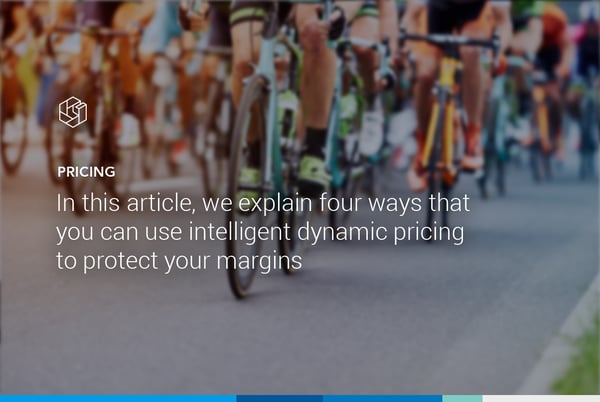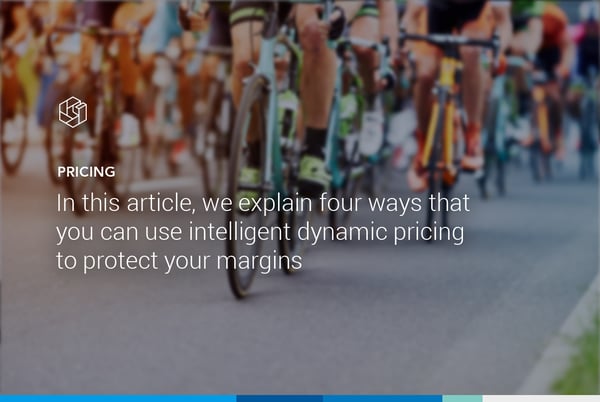Price Points by Omnia Retail

25.02.2019
4 Categories Where Dynamic Pricing is on the Rise
As mobile shopping, the demand for omnichannel experiences, and the number of products increases across retail categories, so does the need for dynamic pricing to manage it. With roughly 20% of all retail purchases in...
As mobile shopping, the demand for omnichannel experiences, and the number of products increases across retail categories, so does the need for dynamic pricing to manage it. With roughly 20% of all retail purchases in the UK made online, it’s obvious that the retail landscape is becoming more digital. Curious about which industries can benefit the most with dynamic pricing? Keep reading. In this post we’ll examine 4 different categories where dynamic pricing is on the rise and give insights on how companies can harness the power of data for better prices. 1: Fashion Fashion continues to grow significantly online, and is a category to watch in 2019. This shift is largely driven by a few major factors: The connected consumer Traditionally powered by in-store sales, the fashion industry is currently struggling with the shift towards online. In particular, the industry has a hard time grappling with the fact that consumers are always “on” — they can buy products whenever they like, wherever they like. Technology makes consumer shopping unpredictable, which makes it hard to please customers. The result is that retailers slash prices without strategy, which drives a (perfectly avoidable) race to the bottom. Vanishing seasonality Additionally, the concept of seasonality is changing within retail. In the past, consumers could only purchase whatever products were in-store at that moment, most of which were dictated by the season. Sundresses and swimsuits were typically sold in the summer, while coats and parkas were sold in the winter. In an online store though, consumers don’t need to wait for a change of season to buy a product. Instead, consumers expect retailers to have every product available at all times. Rise of sports fashion Finally, the trend towards “athleisure” means that the entire fashion marketplace is shifting as the definition of “fashion” changes. New players can now enter the market with a bang, and sports retailers can edge further into a realm that’s traditionally eschewed “sporty” looks. Shifting dynamics Fashion brands and merchants are losing the power to set the prices on their products outside of their own stores. Instead, retailers are taking control and working within the market to set a price. Zalando, for example, use price as one of its spearheads to achieve their exponential growth. The company forgoes the traditional pricing strategy of sale (for example, a 50% discount on swimsuits at the end of the summer). Instead, Zalando, and other retailers with huge footprints online, continually adjust prices dynamically. Major fashion retailers have a first-mover advantage if they act fast enough in adopting dynamic pricing. And if you have a brick-and-mortar store, you have an opportunity to create a unique omnichannel experience for consumers in an industry does still command a lot of footfall. 2: Health and Beauty Health and Beauty is another category that’s growing rapidly online in 2019. In the UK alone, this category is set expected to grow at 16.5% each year until 2023, and this mirrors similar growth in the Netherlands as well. But the larger, traditional players are shrinking in their market share. This is because there is a new wave of Health and Beauty retailers on the rise: pure online players who offer the same products as brick-and-mortar stores through an internet shop at a dramatically reduced price. This pulls price-sensitive shoppers away from the more expensive retailers like Boots or Tesco. Like Fashion, the introduction of new players on the Health and Beauty market means that price cuts, and the resulting race to the bottom, are a very real threat for retailers. The market is now ripe for fluctuating prices, and as consumers become more aware of price differences, retailers need to be able to respond accordingly. Dynamic pricing allows you to plan for these changes and gives you control over your assortment in a market that is in a constant state of flux. It also lets you set a strategy at the product level, so you can protect your brand’s price perception while also meeting consumer demands for different prices. 3: Home and Garden Home and Garden is our third category that’s ripe for dynamic pricing. Historically, garden and do-it-yourself articles were advertised in leaflets. However, just like with the previously mentioned categories, the shift to an online store has opened up a new, unpredictable consumer market online. However, Home and Garden consumers are limited by locality. If someone is renovating their kitchen, for example, they might buy the tools they need online, but will purchase lumber at their local hardware store. This means that home and garden retailers can count on a certain level of in-store footfall, and use that traffic to drive more sales. The easiest way to optimize for both offline and online sales is by connecting your offline and online sales data in one portal, then using the insights to create a strategy. 4: Food While it sounds surprising, GFC figures show that in the Netherlands, food is the fastest-growing category in terms of consumer online spending. The days of visiting your neighborhood grocery store are quickly eroding as more and more companies offer online purchasing and grocery delivery. Several supermarkets already apply dynamic pricing: Jumbo mainly determines the price through close competition and uses the pure player Picnic the lowest price guarantee. In this respect, the UK is ahead of the Netherlands, where it is already possible to compare the price of a shopping basket between different retailers. This is a trend that many industries follow as dynamic pricing becomes more mainstream: as the frequency of price changes increases, consumers begin comparing prices online. Comparison shopping engines like those previously mentioned spring up. Conclusion The growth in online spending and the increasing frequency of the number of price changes means dynamic pricing is more relevant, and sometimes even necessary, in an increasing number of product segments. And while it might seem scary to switch to a dynamic pricing model in the beginning, the reality is that dynamic pricing gives retailers a first-mover advantage. Omnia can help retailers set up pricing strategies for success with our Dynamic Pricing module. Curious about how software can help? Reach out today, and get a two week trial of Omnia for free!
4 Categories Where Dynamic Pricing is on the Rise
20.09.2018
Improve Your Buying, Supply Chain, and Marketing with Pricing Insights
As a retailer, the only way to reach your full potential is to apply data-driven pricing. Otherwise you’ll be paying too much for your products, holding too much stock and wasting money on marketing. Using three...
As a retailer, the only way to reach your full potential is to apply data-driven pricing. Otherwise you’ll be paying too much for your products, holding too much stock and wasting money on marketing. Using three examples we can illustrate how pricing software can give different departments the insights they need to take the right decisions.Many companies (particularly the bigger ones) have a silo mentality when it comes to pricing, procurement, supply chain and marketing. Although pricing is a crucial factor in optimising profit, departments rarely share pricing data and insights. 1. Buying: conduct data-driven negotiation with suppliers In many retail organisations the buyers negotiate with suppliers once or twice a year. Traditionally buyers have tried to obtain a small percentage discount on purchase prices for full ranges. Using pricing software creates room for improvement in two areas. In the absence of pricing insights, a buyer will attempt to obtain the highest possible discount percentage, but will be unable to explain why such a discount should be given. Pricing data can be used as a trump card: the buyer can base the proposed discount percentage or amount per product on the lowest price in the market. Rather than sitting down with suppliers once or twice a year, the procurement department can align the frequency of negotiations more closely with daily or weekly changes in market prices. Pricing software can provide the buyer with a daily or weekly report on all products whose minimum price in the market is below the zero-margin price. This report can then be used as the basis for data-driven negotiations with suppliers. 2. Supply chain: estimate sales more accurately In the absence of data, most retailers and their buyers don’t take the price position of a product into account when deciding how much of it they want to stock. With pricing software reports that provide insights into the price position of each product, your buyers will be able to make more accurate estimates of the number of products that will be sold. For instance, such a report may show that you’ll need to negotiate on a better purchase price before buying new stock. 3. Marketing: only advertise for competitive products It may seem strange, but at most major retailers there’s no communication between the marketing department and the pricing department. As a result consumers may see adverts in which your products are more expensive than your competitors’ products. This results in lower conversion rates and negative price perception. Pricing software allows you to take pricing data into account in offers on Google Shopping. For instance, you can exclude products for campaigns where the price is more than 20 percent higher than a competitor’s average price. Another smart option is the possibility to reduce the offer when the price position in Google Shopping is higher than number 5. Conclusion Unless you’ve got a monopoly, you need pricing insights to make effective procurement, supply chain and marketing decisions. In practice, however, retailers’ departments rarely (if ever) exchange sufficient pricing data. Pricing software fills in this gap. It means that departments are no longer dependent on each other for information – they always have all the relevant pricing data on hand. Omnia Retail helps retailers and brands automate and optimize their pricing. Pricewatch gives you a 360° view of the entire pricing landscape. Dynamic Pricing automates your pricing for individual products. Want to find out more? Ask for a demo and try Omnia for two weeks free of charge.
Improve Your Buying, Supply Chain, and Marketing with Pricing Insights
22.08.2018
Four Ways to Use Dynamic Pricing to Prevent a Race to the Bottom
As a retailer, you’d prefer not to see your competitors undercut your prices. But at the same time, you want to avoid a race to the bottom at all costs. In this article, we explain four ways that you can use intelligent...
As a retailer, you’d prefer not to see your competitors undercut your prices. But at the same time, you want to avoid a race to the bottom at all costs. In this article, we explain four ways that you can use intelligent dynamic pricing to protect your margins. More and more retailers are using intelligent dynamic pricing solutions to ensure that their prices are never undercut by competitors. This often prompts retailers to worry: if all companies start using dynamic pricing software, won’t this cause a race to the bottom, driving prices down so far that our margins will completely evaporate? On the contrary, this can be avoided, provided that you use an intelligent dynamic pricing solution. Unlike simple dynamic pricing, this intelligent software doesn’t simply follow the lowest price in the market. It also takes account of your commercial strategy and company-specific variables (such as buying prices and stock levels). 1. Implement your commercial strategy As the CEO of Coolblue, Pieter Zwart, said during the ING Business Boost: “In the end, there is only one thing that allows you to distinguish yourself online and that is the price. Since I have 60,000 competitors in the Netherlands alone, you can understand that this is a race to the bottom.” Despite this challenge, Coolblue is showing significant profitable growth. How do they realize this? “It’s not about the photo, the price or the buying button. It’s about the entire customer journey. It’s not only about the product that you offer, but about the complete need you are trying to meet with.” So for the purposes of your commercial strategy, it’s important to bear in mind that consumers don’t only look at prices. For instance, if you’re a retailer who offers fast delivery and payment after delivery, the consumer will be more willing to pay a premium price. Your market position within the product category also plays a role: if you’re the market leader or a niche retailer, you have more scope to charge premium prices. You can implement this kind of pricing strategy effectively if you use software for dynamic pricing. 2. Take advantage of the price elasticity of products Price elasticity is the extent to which demand for a product changes as its price rises or falls. For instance, a TV may be highly elastic, but a TV wall mount is not. When it comes to this kind of upselling product, consumers don’t generally compare prices. The same applies to articles that are relatively cheap anyway. This reduces the need to follow the lowest price in the market and enables you to widen your margin. 3. Make stock levels a factor in your pricing Many retailers currently adopt a reactive pricing strategy, reducing prices significantly once stock becomes unsellable. Dynamic pricing allows you to make stock levels a factor in determining the optimum price, so that you can optimise demand and supply. Is your stock at risk of becoming unsellable? Then cut the price to secure the lowest price position on Google Shopping, so that the product will start selling again. 4. Try the high-runner strategy The high-runner strategy is a clever strategy that has been used to great success by Amazon. It offers its biggest discounts on its most popular products, while making profits on less popular ones. Consistently low prices on the highest viewed and best-selling items drives a perception among customers that you have the best prices, taking advantage of the psychology of price perception. Another advantage is that you attract a lot of customers to your website because of these popular and competitively priced products, which provides the opportunity to cross or up sell other products with better profit margins. Intelligent dynamic pricing software makes it easy for you to configure the variables for determining your high runners, for instance the number of views or number of products sold. The algorithm of Omnia Retail’s Dynamic Pricing module determines your optimum prices based for instance on price elasticity, variables in your own system and competitor pricing data from Pricewatch. It then makes automatic adjustments. The flexible pricing business rules enable you to implement any pricing strategy that you want. Want to find out more? Ask for a demo and try Omnia for two weeks free of charge.
Four Ways to Use Dynamic Pricing to Prevent a Race to the Bottom
07.08.2018
Boost Sales by Incorporating Weather Changes into Pricing Decisions
The effect of the weather on retail sales cannot be underestimated. The recent spell of hot weather in the UK and most of Europe has certainly had an impact on retail performance across various sectors. However, several...
The effect of the weather on retail sales cannot be underestimated. The recent spell of hot weather in the UK and most of Europe has certainly had an impact on retail performance across various sectors. However, several marketing departments still poorly utilize links between marketing decisions and the weather. Understanding these links would give them a framework to take the weather changes into account, and thus potentially increase sales and profits. Omnia's algorithm includes input from a weather API in calculating optimal price and CPC bids so can easily incorporate weather changes into their pricing and marketing decisions. This blog describes examples of how incorporating the weather forecast in your commercial strategy can boost both your sales, as well as your profits. Increase Google Shopping bids for weather-sensitive products For some product groups, there is a correlation between weather changes and sales probability. As the probability of conversion depends on the temperature, a retailer wants to take advantage by adjusting Google shopping bids dynamically, based on the weather. Manually, it isn’t possible to do this for your complete assortment. Therefore, Omnia offers you the possibility to incorporate this automatically into your bid calculation. Read more: The Ultimate Guide to Dynamic Pricing The example below shows that you can increase bids when the weather forecast shows that the temperature will exceed XX degrees. Based on experience, we all know that when the temperature increases, consumers will, for example, start searching for air conditioners and are more likely to buy (e.g. higher probability of conversion). As a retailer, you can take advantage of this by using a business rule that increases your Google Shopping bid for this product group. Another case in which weather data could be valuable is as winter approaches. When the temperature decreases, and chance of frost starts to increase, search volume for ice skates will increase. The weather API allows you to not only adjust your bids and prices based on temperature, but also on for example chance of frost or snow. Increase prices for weather-sensitive products Weather data could also help to boost profits when it is incorporated to a retailer’s pricing strategy. Several retailers did not anticipate the recent spell of hot weather and as a result they run out of their inventory of for example air conditioners. Whenever there’s limited supply available, a retailer may want to optimize profit by using a combination of weather data and their inventory. In this scenario, a business rule could be: If: ‘# Stock months = (inventory / # units sold last 28 days) < 2’ And: ‘Temperature in 2 days is greater than 25 degrees‘ And: ‘Product group is equal to air conditioners’ Then: Take XX% margin This business rule ensures you won’t price too competitive when it’s not needed and optimize profits when demand exceeds supply. Concluding Weather can affect the sales of certain products. Omnia makes it easy for every retailer to boost profits by automatically adjust prices and cpc bids for weather-sensitive products. Are you interested to learn more about what Omnia’s software could offer for your company? Request more information or a demo here or give us a call at +31 (0) 85 047 92 40.
Boost Sales by Incorporating Weather Changes into Pricing Decisions
28.05.2018
Unlocking the Pricing Data Potential: Make Better Buying and Marketing Decisions
Well-managed companies recognize the critical role pricing plays in driving performance. A foundation (e.g. organization’s structure) that underpins excellence in pricing is key to realizing its full potential. However,...
Well-managed companies recognize the critical role pricing plays in driving performance. A foundation (e.g. organization’s structure) that underpins excellence in pricing is key to realizing its full potential. However, large corporates usually have teams that work separately on topics such as pricing, buying, marketing, and supply chain. Based on Omnia’s experience there is a missing link between those teams that could add a lot of value when fully exploited. Since the marketing and supply chain department usually do not have access to pricing data, they might advertise and purchase different products than they would do if they would have access. This blog explores three examples how Omnia could facilitate the bridge between those teams, thereby enabling them to make better, data-driven decisions and realize pricing data’s full potential. 1. Pricing & Buying In a lot of organizations buyers will have supplier negotiations once or twice a year. Traditionally, a buyer would aim for a few percent purchase price improvement on the complete assortment they offer. With the increased frequency of price changes and price transparency, this traditional set-up of the buying process has two cons: 1. The purchase price improvement % or amount a. Traditional situation: without access to pricing data, a buyer would aim for the highest % as possible b. Ideal situation: data-driven % or amount per product based on lowest price in the market instead of a random number 2. Frequency a. Traditional situation: negotiations once or twice a year b. Ideal situation: frequency of negotiations in line with pricing dynamics of the market (e.g. daily or weekly) In Omnia, both cons can be solved quite easily by setting up a report. This report contains all products for which the minimum price in the market is below your zero margin price (e.g. you’re not able to match that price due to your purchase price), can be sent daily or weekly to the buyer’s e-mail (or directly to the supplier) and this can be used to start data-driven negotiations with suppliers. 2. Pricing & Supply chain We typically see that most retailers do not take price position per product into consideration when deciding what and how many products to stock. This is not because they not want to, but due to lack of data. Usually, first, a buyer decides what products to buy. At that moment it would be helpful to know your price position per product (e.g. will it be competitive), as it enables supply chain to give a more accurate estimate of how many products you will approximately sell. In Omnia, you can easily set-up a report that shows price position per product, which can be used as additional input for supply chain. This report can, for example, show an alert that advises negotiating a better purchase price before you take it on stock. Once you have a product on stock, it might happen that competitors decrease their price and you’re not competitive anymore. In Omnia, you can set-up a report that shows products with a lot of views but low conversion, which might be due to the price position. This report can be used by: Buyers; to get compensation for those products Supply chain; so they won’t order those products until the buyers managed to get compensation 3. Pricing & Marketing In large corporates, we typically see that the marketing department, who decides what products to advertise and what advertising budget will be allocated per product, do not communicate with the pricing department, who know the margin and the price position of those products. Without access to price position data, marketers might spend advertising money to show they are outpriced versus competition. Those ads obviously result in low conversion rates and negative price perception. In order to avoid this Omnia enables clients to incorporate pricing data in bid calculation, thereby enabling them to for example exclude products to marketing channels for which their price is more than 20% above the competitor average price or decrease the bid when price position is greater than position 5. Read this blog to learn more about the added value of using pricing data as structured input for online marketing decisions. To conclude Every business that offers branded products, offered by more than one retailer, needs pricing input for both buying as well as marketing decisions. Therefore, there should be communication (e.g. share data insights) between the people who are responsible for pricing, buying, marketing, and supply chain in an organization. By sharing those pricing insights on a frequent basis, the pricing data potential could be fully exploited by using it as structured input for buying, supply chain, and marketing decisions. Omnia enables retailers to automate this communication process through the set-up of reports and built-in features to use price position in bid calculations for marketing campaigns. In case you’d like to learn more about what Omnia’s software could offer for you, request more information or a demo here or give us a call at +31 (0) 85 047 92 40.
Unlocking the Pricing Data Potential: Make Better Buying and Marketing Decisions
22.02.2018
Dynamic Pricing: Relevant for Every Retailer?
Prices from large retailers are rarely static anymore. More often, retailers make use of dynamic pricing: they use intelligent software to adjust prices multiple times a day. Prices may be automatically adjusted when,...
Prices from large retailers are rarely static anymore. More often, retailers make use of dynamic pricing: they use intelligent software to adjust prices multiple times a day. Prices may be automatically adjusted when, for example, stock levels at competitors are decreasing, when there is shown more interest in a product or when the weather forecast changes. Large retailers such as Amazon change their prices as often as every ten minutes. The success of industry leaders like Amazon shows that Dynamic Pricing is critical when organizations want to succeed in the e-commerce and omnichannel retail industry. But how does Dynamic Pricing work? And is Dynamic Pricing equally relevant for all retailers, big and small? Using a dynamic pricing strategy is not a new thing. It became popular in mainstream business years ago when the travel industry adopted the practice. Today, dynamic pricing is also common practice in the retail industry. Some of the largest retailers in the world, including Amazon and Alibaba, all employ the strategy in their e-commerce online stores. Dynamic pricing is also being used more and more in physical stores. Mediamarkt, for example, was one of the first retailers in the Netherlands to introduce digital shelf labels. How does it work? In short, dynamic pricing is a pricing strategy which applies variable prices instead of fixed prices, with the aim to increase a companies profit and margins. New, optimal prices are calculated and recalculated periodically, up to multiple times per hour. Dynamic pricing uses multiple sources of data, including internal and external data variables to find the optimal price. Internal variables, such as stock levels and sales data are enriched with external variables such as competitor pricing and Google Analytics data by dynamic pricing software. As more data is analyzed, the right price at the right time can be calculated for each product. Before starting with dynamic pricing, it’s important to have set a clear pricing strategy. An intelligent dynamic pricing software will combine your chosen pricing strategy with all the described data sources, to find optimal prices that fit your business pricing strategy; whether that’s market penetration, maximization of revenue or something else. In general, dynamic pricing will yield a growth in contribution of 10-20%, compared to static pricing. However, there are notable differences in performance between the different types of dynamic pricing. A basic type of dynamic pricing is a rule-based pricing system. When dynamic pricing is used this way, prices are adjusted according to certain rules, such as: follow prices of competitor X. Another, more advanced method of dynamic pricing, is a value-based pricing system. In a value-based system, price elasticity of products is an important factor in calculating the optimal price. The latter, more advanced type of dynamic pricing often yields better results than the basic, rule-based dynamic pricing system. One basic way a rule-based dynamic pricing can add value, is to implement pricing rules based on stock levels. Such rules can help protect a retailers margins if a competitor should decrease prices, potentially caused by a surplus of stock. If stock levels are lower than the beforehand determined limit for stock weeks (stock / sales per week), it’s not necessary to follow the lowered price and thus lose margins. Conversely, the same is true: by implementing rules to decrease price as soon as stock levels exceed a set limit, a retailer can make sure they’re not losing sales. Who benefits with dynamic pricing? Whether Dynamic Pricing is relevant for a retailer is partly dependent on it’s competitors pricing strategy. Do competitors deploy a dynamic pricing strategy, but the retailer keeps its own prices static? It’s very likely the retailer is losing sales. An increasing amount of retailers, both large players and smaller niche businesses in different industries, are making use of dynamic pricing. In order to quantify the potential added value of dynamic pricing, a retailer can start with systematically comparing its own pricing to the pricing of its biggest competitors, in order to assess if and how many times a day competitors are changing their prices. A retailer can also track to what extent competitors react to its own price changes. This may lead to the conclusion that one or more competitors are using dynamic pricing. If that’s the case, the retailer can benefit from taking action in dynamic pricing too. An often-heard concern is that when all companies in the same industry would use the same dynamic pricing software, wouldn’t that result in a race to the bottom? Fortunately, this is not the case. Since both the commercial strategy as well as the input variables (e.g. purchase price, inventory) vary per company, there is no reason to end up in a race to the bottom. A retailer’s commercial strategy influences pricing, because the consumer is generally willing to pay a premium price for extra services such as fast delivery, customer service, or the possibility to pay by invoice. Often, the most optimal price is not the same as being priced the lowest in the market. To answer the question whether it’s interesting for the smaller retailer to start with dynamic pricing? It depends on their competitors pricing strategy, the industry and their commercial strategy. In most cases, we know from experience that retailers can achieve quick wins by gaining insights in competitor pricing, and by implementing a basic rule-based dynamic pricing system with rules based on stock levels. Do you want to learn more about dynamic pricing? Subscribe to our newsletter to receive our new blogs in your inbox, or request more information here. You can also give us a call at +31 (0)85 047 92 40.
Dynamic Pricing: Relevant for Every Retailer?
13.02.2018
How to Avoid a Race to the Bottom with Dynamic Pricing
With today’s pricing transparency, price has become one of consumers’ key purchase decision factors. Shops navigate a tricky path when it comes to pricing: they don’t want to be undercut by competitors and lose sales,...
With today’s pricing transparency, price has become one of consumers’ key purchase decision factors. Shops navigate a tricky path when it comes to pricing: they don’t want to be undercut by competitors and lose sales, but they also don’t want to get caught in a “race to the bottom” where price cutting gets so extreme that margins completely disappear. In a race to the bottom, competitors fight fiercely for the customer due to continuous price reductions. To escape this, shops are increasingly using intelligent dynamic pricing software solutions. An often-heard concern is that when all companies in the same industry would use the same dynamic pricing software, wouldn’t that too result in a race to the bottom? Fortunately, this is not the case. Since both the commercial strategy as well as the input variables (e.g. purchase price, inventory) vary per company, there is no reason to end up in a race to the bottom. Intelligent dynamic pricing, instead of very basic dynamic pricing by simply following the lowest price in the market, actually enables stores to avoid the race to the bottom. This blog post outlines four ways how to use intelligent dynamic pricing strategies that can help you avoid a race to to the bottom and protect your margins. 1. Use your commercial strategy As CEO of Coolblue Pieter Zwart stated during the ING Business Boost: ,,In the end only one thing remains with which you can distinguish yourself online and that is the price. Since I have 60,000 competitors in the Netherlands alone, you understand that this is just a race to the bottom.’’ Despite this challenge, Coolblue drives significant profitable growth. What is their secret? ,,It’s not about the picture, the price or the buy-button. It concerns the entire customer journey. It is not just about the product you offer, but the complete need that you are trying to satisfy with that.’’ A shop’s commercial strategy influences the price because the consumer is generally willing to pay a premium price for extra services such as fast delivery, customer service or the possibility to pay by invoice. Another important commercial factor that plays a role, is the market position within the specific product category: being the destination store or a specialist/niche store could allow for a bit of a premium price. Analysis by A.T. Kearney shows that retailers with a large market share and high contamination risk could use premium pricing. Price contamination occurs when competitors quickly match a company’s pricing moves and when consumers switch providers as soon as they learn about a lower priced alternative. In many cases the optimal price is therefore not equal to the lowest price in the market. Since the commercial strategy is essential for determining the optimal price, the commercial and pricing strategy should be clearly defined before starting the implementation of dynamic pricing. The company’s overall strategy should translate to pricing tactics per category, based on the roles of categories within the retail format. A store with a broad assortment, may for example want to use aggressive pricing in a new product category to get market share whereas they may use premium pricing in a product category where they already have established significant market share. Dynamic pricing software usually offers complete flexibility to automate the pricing strategy through the creation of pricing business rules. A shop offering a high value proposition with several free services can for example: choose the most frequent price in the market + XX% and set a target margin level per product group or brand (or any other level), making sure profits will be dynamically protected to competitor’s price reductions. 2. Use price elasticity The price elasticity of demand measures the responsiveness of quantity demanded to changes in the price of the product. Elasticity per product(group) provides insights in how competitive the pricing needs to be. For example a TV is usually high elastic, whereas demand for a wall mount is less sensitive to price changes. In practice, it means that increasing the price for the TV by 10% results in a significant decrease of volume while increasing the price for the wall mount by 10% may negligible affect volume and therefore the right thing to do. Typically non-elastic products are ‘add-on’ products for which consumers generally do not compare prices or products with a low absolute price point, for which doing pricing research isn’t worth the time for shoppers. For those products there is less need to follow the lowest price in the market. 3. Use your stock levels Next to price elasticity, inventory levels are another important variable to make better pricing decisions in order to optimize profits. Early adopters of dynamic pricing, such as the airline industry, are characterized by having a fixed short-term capacity and relatively low variable costs. In such settings, it is the available capacity, for example, the number of seats still available on a flight, that causes prices to change throughout time. For several other industries using capacity or stock levels based on business rules in pricing, it also helps to optimize supply and demand and to avoid obsolete inventory. Usually a shop would reduce the price by a significant percentage after a product has become obsolete. Business rules based on stock levels could help to protect a store’s margin in case a competitor decreases its price because of obsolete inventory. If your inventory for this product is below your set limit of stock weeks or months (#units in stock divided by #units sold last 4 weeks), there’s no need to adjust the price and give away margin. The example underneath shows that if your stock coverage is less than 4 weeks and your stock age (# days in inventory) is less than 30 days the minimum margin should be 20%. One could also use the most occurring price point. Business rules on stock levels could also help to optimize profits for your own stock levels. Instead of static and reactive price reductions, business rules based on stock coverage dynamically adjust prices to stock levels. You may for example need to reduce your price by only a few percent to take the first price position on Google Shopping, instead of the static X% on the complete obsolete assortment. Proactively managing your stock levels could lead to a significant increase in contribution margin. In combination with Pricewatch, Omnia offers the unique opportunity to incorporate pricing data in the bid calculation. If you already have the first price position in Google Shopping, it may be more interesting to increase bids instead of further reducing the price. 4. Use a high-runner strategy Amazon uses a clever strategy that makes it seem like it undercuts its competition more often than it does. It offers its biggest discounts on its most popular products, while making profits on less popular ones. In Omnia you could implement this by using a high-runner strategy. You can choose a variable to select high runners: number of views, quantity sold or anything else. Consistently low prices on the highest viewed and best-selling items drives a perception among customers that you have the best prices, taking advantage of the psychology of price perception. Another advantage is that you attract a lot of customers to your website because of these popular and competitively priced products, which provides the opportunity to cross or up sell other products with better profit margins. Closing remarks These are only a few examples of how Omnia’s dynamic pricing software could help to avoid a race to the bottom. More information about Omnia? Don't hesitate to get in touch, or give us a call at +31 (0) 85 04 79 240. Talk to one of our consultants about dynamic pricing. Contact us Curious to learn about other pricing strategies or interested in our Amazon guide series? Check out some of our other articles below: What is Value Based Pricing?: A full overview of how price and consumer perception work together. What is Charm Pricing?: A short introduction to a fun pricing method. What is Penetration Pricing?: A guide on how to get noticed when first entering a new market. What is Odd Even Pricing?: An explanation of the psychology behind different numbers in a price. What is Bundle Pricing?: Learn more about the benefits of a bundle pricing strategy. What is Cost Plus Pricing?: In this article, we’ll cover cost-plus pricing and show you when it makes sense to use this strategy. What is Price Skimming?: Learn how price skimming can help you facilitate a higher return on early investments. What is Map Pricing?: Find out why MAP pricing is so important to many retailers. Here’s What You Need to Know About Psychological Pricing (Plus 3 Strategies to Help You Succeed): Modern day pricing is so much more than a numbers game. When thought about correctly, it’s a powerful way to build your brand and drive more profits. How to Build a Pricing Strategy: A complete guide on how to build a pricing strategy from Omnia partner Johan Maessen, owner of Commercieel Verbeteren. The Strategies Behind Amazon's Success: Learn how Amazon became 'the place' to buy products online. The Complete Guide To Selling on Amazon: In this guide we answer some of the top questions we hear about Amazon and give helpful hints on how to succeed on the platform. How Does Amazon's Search Algorithm Work: Find out how Amazon connects their shoppers with relevant products as quickly as possible. Price, The Most Important P in the Marketing Mix: In this article we'll look at the relevance of the 7 P’s in today’s online marketing context.
How to Avoid a Race to the Bottom with Dynamic PricingSign up to be the first to get information from Omnia.
Sign up now